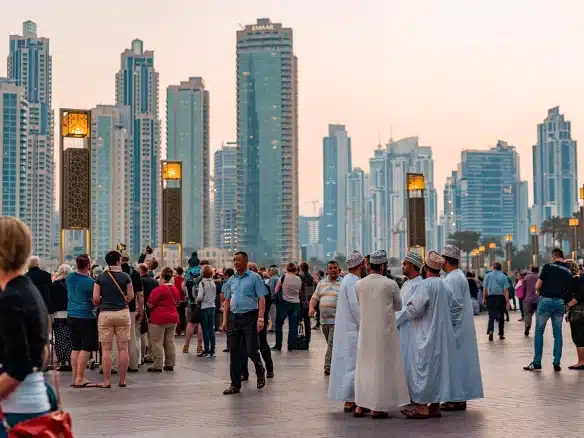Introduction
The real estate market in Dubai for 2025 presents a complex but opportunity-rich landscape. After several years of strong growth, the market is now entering a more nuanced phase: continuing momentum in many areas, but with clear signs of structural shifts, risks and changing buyer behaviour. In this blog we’ll examine the key trends, drivers & risks, what they mean for buyers/investors, and strategic take-aways for those looking at Dubai property this year.
Key Trends in 2025
Here are the most important trends shaping Dubai’s property market in 2025, drawn from recent expert research and market data.
1. Strong Transaction Volumes & Buyer Interest
- In the first half of 2025, Dubai’s real estate transaction value surged: figures show more than AED 431 billion in transactions in H1 alone.
- A large share of sales are “off-plan” (i.e., properties purchased before completion) – this is a major part of current activity.
2. Price Growth but Deceleration in Some Segments
- While price levels continue to increase, growth is decelerating in some segments. For example, the monthly price index for January 2025 recorded a 0.57 % month-on-month decline — the first drop since mid-2022.
- According to Fitch Ratings, there is a risk of a moderate correction (price falls) of up to ~15 % in residential property prices in the second half of 2025 and into 2026, due to increased supply.
3. Supply Surge & Emerging Oversupply Risk
- Significant new supply is scheduled: estimates suggest circa 182,000 new residential units will come online in 2025-2026.
- The large influx of units (especially apartments) increases the risk of oversupply, which could dampen price/rental growth in certain segments.
4. Shift in Buyer & Product Preferences
- There is a growing focus on sustainable, smart, community-oriented developments (eco-amenities, wellness, integrated living).
- A rise in end-user/owner-occupier demand (not just investors/speculators) is notable, especially at the luxury end.
- Emerging interest in suburban or peripheral communities as buyers seek more space, value, and lifestyle alternatives.
5. Rental Market Dynamics
- Rental growth remains positive, but also shows signs of moderating. For example, in May 2025, annual rental growth for residential in Dubai was ~8.5%, down from ~21.1% a year earlier.
- Apartments have shown stronger rental growth (~9%) compared to villas in that period.
6. Luxury / Prime Segment Resilience
- The high-end luxury residential market remains robust: for example, Q1 2025 saw 111 transactions above USD 10 million, a 5.7% increase year-on-year.
- Demand from wealthy international buyers continues to underpin the prime segment.
Drivers Behind the Trends
Understanding what is causing these trends helps to interpret how long they might persist or how deep the risks could be.
- Population & international flows: Dubai continues attracting global buyers, and the resident population is growing, which supports housing demand.
- Government policies & regulation: Dubai’s real estate and residency policies (freehold zones, visas, investment-friendly regulations) make it attractive.
- Global comparisons & safe-haven appeal: In a world of economic uncertainty, Dubai is seen as a relatively stable place to own real estate.
- Product evolution: Developers are responding to changing buyer tastes (wellness amenities, smart homes, integrated communities) which helps maintain demand.
- Supply chain & delivery timing: Many projects pre-sold during boom periods are now delivering, which adds stock to the market and changes dynamics.
Risks & Caveats to Watch
While many signs are positive, a prudent outlook must consider the risks:
- Oversupply: The surge in new completions, especially of apartments, may outpace demand in some segments or areas, causing downward pressure on prices/rents.
- Affordability constraints: As prices rise, fewer buyers might be able to pay premium rates, especially for ready units in non-prime locations. For example, a slowdown in monthly price growth (or a small drop) was recorded in January 2025.
- Global economic risks: A global downturn, rising interest rates, or regional instability could impact foreign buyer flows or financing terms.
- Segmental differences: Not all parts of the market behave the same. Luxury villas may remain strong while mid-tier apartments in oversupplied locations may weaken.
- Timing risk for off-plan: Buyers purchasing off-plan must consider delivery risk, execution risk, and how market conditions might change by the time of hand-over.
- Rental market slowdown: While still positive, rental growth is moderating – this matters for buy-to-let investors.
What This Means for Buyers, Investors & Occupiers
Here are some strategic implications depending on your role:
For Investors
- Focus on locations with strong fundamentals: prime addresses, limited future supply, high barriers to entry.
- Consider product type: luxury villas/prime apartments may offer more resilient value; mass-market apartments might carry more risk of oversupply.
- Pump for rental yield: With rental growth moderating, it’s important to assess realistic yields and potential for capital appreciation. For example, yields in apartments may roughly be in the 5-7% range in some areas.
- Check delivery timelines and the reputation of the developer for off-plan purchases.
- Keep an eye on market correction risk: if prices are expected to flatten or correct in some segments, the timing of investment matters.
For Owner-occupiers / Home Buyers
- For buying a home to live in: the market is still active, and you have choice – but negotiate carefully and check build quality, hand-over dates and community infrastructure.
- If you’re flexible in timing, you may benefit from softened pricing or better deals in segments under pressure.
- Consider longer-term lifestyle factors: community amenities, infrastructure, connectivity will matter more than short-term price moves.
For Renters
- With rental growth slowing, you may have more negotiation power in certain locations — especially less-prime areas with new supply.
- If you are considering buying instead of renting, assess whether buying now makes sense vs continuing to rent given the local conditions and your personal timeline.
Strategic Outlook: What to Watch in the Rest of 2025 & Beyond
Here are some forward-looking points to monitor:
- Supply absorption rate: How quickly the new units (2025-26 completions) are absorbed will determine whether price growth continues or slows. A large backlog could swing the market.
- Segmental divergence: Luxury vs mass-market, hand-over vs ready-to-move-in, core vs fringe locations may diverge significantly.
- Regulatory changes / financing conditions: Any tightening in mortgage terms, changes in foreign ownership rules or visa/regulation tweaks could impact demand.
- Rental market dynamics: If rentals flatten or decline, investors may face pressure; if they hold up, that supports investment.
- Macro and global outlook: Global economic performance, interest rates, oil prices, regional geopolitics will influence investor sentiment and foreign capital flows.
- Exit strategies for investors: Given potential for moderation/correction in some segments, focus on how you will exit or hold property for longer-term value vs short-term gain.
Summary & Final Thoughts
2025 for Dubai’s real estate market can be summarised as follows:
- The market remains strong, with high transaction volumes and continuing demand, especially from international buyers and in prime segments.
- But the pace of growth is moderating, supply is increasing, and not all segments are equal – oversupply risk is rising, and timing matters.
- For investors and buyers, the key is to be selective: location, product type, quality, developer and timing matter more than ever.
- For owner-occupiers, it remains a viable market to buy, but due diligence and realistic expectations are essential.
- The market is likely to shift from a high-growth phase into a consolidation/maturation phase, where value retention and rental yield become more important than rapid capital appreciation.




